Back
Back
Mastering Situational Sales Negotiations: A Comprehensive Guide
Mastering Situational Sales Negotiations: A Comprehensive Guide
May 31, 2024



Not sure about you, but I'm eagerly waiting for Season 2 of Severance.
In watching the first episode of the first season, one particular scene depicted exactly what sales negotiations can feel like – especially if you're unprepared.
The lead character, Mark Scout, has just been promoted to Department Head at his job in Lumon Industries' Macrodata Refinement (MDR) division. His first task as DH is to orient and train Helly, his coworker, on her new "reality" at the job. (It's a sci-fi psychological thriller, so the word "reality" doesn't exactly live up to its meaning.)
During the orientation, Scout finds himself feverishly shuffling through pages and pages of "talking points," including icebreakers, common questions, objections, and counter-objections, so he can know exactly what to say, regardless of the situation.
And even with all of those resources at hand, he still finds a way to mix things up and get ahead of himself. And even if he could somehow manage to memorize the whole thing, he could still mess things up.
That's because, while a sales negotiation is absolutely about the context surrounding it, the person (or people) you're selling to can shift that context in a snap.
This is the exact frame of mind I want you to have when thinking about situational sales negotiations.
What Are Situational Sales and Why Are They Different?
Every sales experience will be different regardless of how experienced you are. Sometimes, selling will feel relatively easy. Other times, it'll feel like a million punches are being thrown at you, and, just like John Wick, you need to swerve each of them masterfully.
Either way, you need to be ready for the latter option – because situational sales can be a "different species."
So, what are situational sales negotiations?
Simply put, it's the ability to adjust your approach based on many situations during the sales process, such as a customer raising unexpected objections, changes in budget or priorities, new stakeholders entering the decision-making process, or shifts in market conditions.
"So, is every B2B sales negotiation situational?"
Yes. Yes, indeed. But for some, the context won't shift as much (especially for high-intent and motivated buyers), and you won't need to maneuver so many "punches." That said, some negotiations will feel like your skills are being tested because they are.
The team at Profiliant Development Resources said it brilliantly:
"Sales Negotiations are different from all other types of negotiations because while they almost always revolve around price and discounting, each negotiation encounter can be daunting. The situation changes frequently, and the salesperson is almost always on the receiving end of demands for concessions."
In other words…taking punches. According to the team, salespeople feel pressured to give discounts, struggle past price committees and procurement officers, and make concessions to barely close the sale.
The key to mastering any situation, no matter how unexpected, isn't to become skilled in the "best sales tips and tricks." Instead, it's to...
Knowing Your Customer
Your target persona. Your ICP. Or any variation thereof.
The other B2B salespeople and I sound like a broken record at this point. But I don't mind.
According to Karan Sood, Director of Sales, B2B Sales Expert, and publisher of the MonetizeThis newsletter:
"Your total addressable market of millions of businesses is not your ideal customer profile. That's a distraction from the exercise of finding the ideal customer. This means rather than casting your customer net wide, you need to narrow it down. Far too often, customers devalue products because you are not selling to your ideal customer."
Not to mention, narrowing down your ICP makes it far easier to research and understand these customers so you can address all of their pain points and motivations during the toughest negotiations.
While on this topic, let's discuss what "knowing your customer" means and how to gather information about them.
Granted, you'll get to know your customers better as you talk face-to-face with them. And that includes nuggets of wisdom during calls. However, you'll still need to gather and analyze as much information as you can get before a meeting, such as:
Identifying key competitors and understanding how the customer differentiates itself in the market.
Reviewing the company's website to understand products or services, mission, values, and any recent news or updates.
Analyzing the company's financial health, growth trajectory, and strategic priorities.
Looking for recent announcements, partnerships, or events that might provide insights into the company's current challenges or initiatives.
Looking at the company's social media profiles to gauge its online presence, engagement with customers, and industry trends.
Bonus points: if you ask open-ended questions, listen actively, probe for pain points, and use empathy during meetings. Those are non-negotiables.
Identifying Key Stakeholders
Today, according to Gartner, "an average of 11 individual stakeholders are involved in a B2B purchase; that number can occasionally flex up to nearly 20.”
That "20" figure might make your skin crawl. Imagine catering to each stakeholder with their own agenda, authority, and influence.
Of course, not all will be key decision-makers. However informed stakeholders can still sway a major decision. You need to engage with initial contacts within the organization to identify who will be involved in the discussions.
This will help you prepare accordingly by addressing the criteria they used to evaluate products or services. Knowing their criteria is essential for aligning your strategy with their decision-making process.
Their criteria can include:
Budget constraints
Required features and integrations
Implementation timelines
Long-term strategic goals
And more.
For example, a CFO might be concerned with cost savings and ROI, while a CTO might prioritize integration capabilities and technical specifications. All of those need to be present during the sales meeting.
What Would a Good Situational Sales Negotiation Look Like In a Real Life Scenario?
Let's fabricate an example with fictional stakeholders and our superstar sales rep, Alex. He's trying to sell project management software for a fictional mid-sized technology company called TechSolutions.
The key stakeholders involved in the call are:
Sarah (CTO) is concerned with technical specifications, integration capabilities, and long-term technology strategy.
John (Project Manager), who’s focused on the software's usability, features, and reliability to streamline project management processes.
Emily (Procurement Officer), who’s responsible for negotiating terms, ensuring cost-effectiveness, and managing the financial aspects of the purchase.
Additionally, other indirect stakeholders, like the finance department, might influence the decision. Alex is well aware of that.
During the call, Alex had to manage several situations. Here are some of them, how he addressed them all, and what you could do to address them yourself.
Competitor Objections
Competition will almost always be an issue. The key is highlighting your unique value proposition and competitive advantages in the context of the call. Especially if stakeholders have been on talking terms with other companies
Here's an excerpt from our fictional call:
Alex: I get that streamlining your project management process is a key priority for TechSolutions. Our software offers advanced features like real-time collaboration, automated reporting, and integration with existing tools. How do you feel these features align with your current needs?”
Sarah (CTO): “The features sound promising, Alex. But we’ve been in talks with AgileMaster as well. They offer a similar suite of tools and have been in the market for a longer time. We’re concerned about the risk of switching to a newer provider when AgileMaster has a proven track record.”
John (Project Manager): “Yes, we’ve been using AgileMaster’s basic version for the past two years. While we’re open to exploring new options, their system’s reliability and our team’s familiarity with their interface are significant advantages for us.”
Emily (Procurement Officer): “Plus, AgileMaster has offered us a huge discount on their enterprise version because we’re an existing customer. We need to make sure that any new solution is not only superior but also cost-effective.
So, AgileMaster offers a similar suite of tools and has been in business for a longer time. You can't compete on years of experience, and in this case, you can't compete on tooling, either. What's more, the team is already familiar with their current workflow.
How can Alex get out of this bind?
By pulling the "switching" lever. This involves payment plans but doesn't involve price reductions. Emily gave him the cue, and he worked it. Here's how.
Price Resistance
Alex: "I understand the budget considerations. We’re willing to offer extended payment terms to make the transition more attractive. So, instead of the standard 30 days, we can extend the terms to 60 days for more flexibility and better cash flow management. This is an offer that AgileMaster doesn’t currently provide."
He continues, “Regarding cost-effectiveness, we offer flexible pricing plans and a dedicated support team to ensure a smooth transition with minimal disruption. We can also give you a detailed ROI analysis to compare our software's long-term benefits and savings versus AgileMaster’s current offering.”
As it turns out, Alex is a Journey user. He did his research and knew this could be a potential objection. As a result, he’s added a dedicated “ROI analysis” section to the Digital Sales Room.
Here's Why That Was a Smart Move
"(It's) fair to say discounting in B2B is the norm and not the anomaly. That goes for all B2B SAAS, non-SAAS, services, etc.," says Sood.
But should it be?
The answer is no. In fact, only three things beat pricing: budget, intent, and value perception.
Having to pull the discount lever constantly could mean that your pricing is hefty or cashflow-unfriendly. However, it's more likely that 1) Potential customers don't have the budget, 2) Their intent isn't as high as expected, or 3) The perceived value of your product doesn't seem to justify its pricing.
Trying to convince them to stretch it won't always be a good idea if they don't have the budget. That's why many salespeople use discounts.
If their intent is lower, they'll need a bit more guidance. That's where value propositions, KPIs, case studies, and video testimonials (collected using testimonial tools) can do a lot of the heavy lifting.
If your product's perceived value is low, you need to quantify and communicate the buying criteria you've identified in your research—such as ROI, total cost of ownership, and the opportunity cost of not taking action.
The pickle is...
You will have to talk about pricing eventually, and I hope it's earlier on. Here's why.
According to research from Gong Labs, close rates are highest when pricing and budgets are discussed in the first 1-2 calls. This technique is also ideal for filtering out prospects whose budgets are too low.
All that said, price and competition aren't the only stones in your shoe.
Other Roadblocks or Impasses
Sometimes, things seem to go smoothly when one unexpected objection sets you back.
A lot of these can commonly be reduced by knowing your product.
To break through this scenario, you need to identify the impasse's root causes and address them immediately. Here's how Alex did it when Sarah threw another punch his way:
Sarah (CTO): "Alex, I have another concern. Given the sensitive nature of our projects, data security and compliance with industry regulations are essential. How does your software ensure data protection, and can it comply with our industry standards?"
Alex: "Could you share more about your concerns and the regulations you must comply with? This will help me better address your questions."
Sarah: "We need to ensure that any software we use complies with GDPR and industry-specific standards like ISO 27001. Our clients entrust us with sensitive information, and any data breach could severely impact our reputation."
Alex: "Thank you. Our software is designed with robust security measures, including end-to-end encryption, regular security audits, and compliance with GDPR and ISO 27001 standards. Our dedicated security team continuously monitors and updates our systems to protect against potential threats. Would arranging a call with our Chief Security Officer to discuss our security protocols in more depth would be helpful?"
Sarah: "Yep, that would be helpful."
Next, he sets up that call and sends over the detailed documentation she requested. He also includes that documentation in the Digital Sales Room so he can be ready for this objection the next time around.
When All Is Said and Done...
You may still face objections and resistance from your customers. Expect that to happen! But don't get worked up over it because you don't need to do it all yourself. Here's what I mean by that.
Like Alex, You Can Offload the Negotiation Burden to Digital Sales Rooms (DSRs)
How, exactly, can DSRs "offload" this burden?
DSRs, especially Journey, are built (and meant!) to impress. They're also meant to simplify the lives of everyone involved – stakeholders AND sales teams. Here’s how:
DSRs are in direct competition with endless email threads and impersonal experiences. Who do you think is gonna win in B2B sales?
One secure link is all you need. If stakeholders need to share it, they'll share it easily, even with those who weren't on the call. That makes it much easier for the champion to sell your solution internally. You can control distribution with email verification, password protection, whitelists, blacklists, and expiration dates.
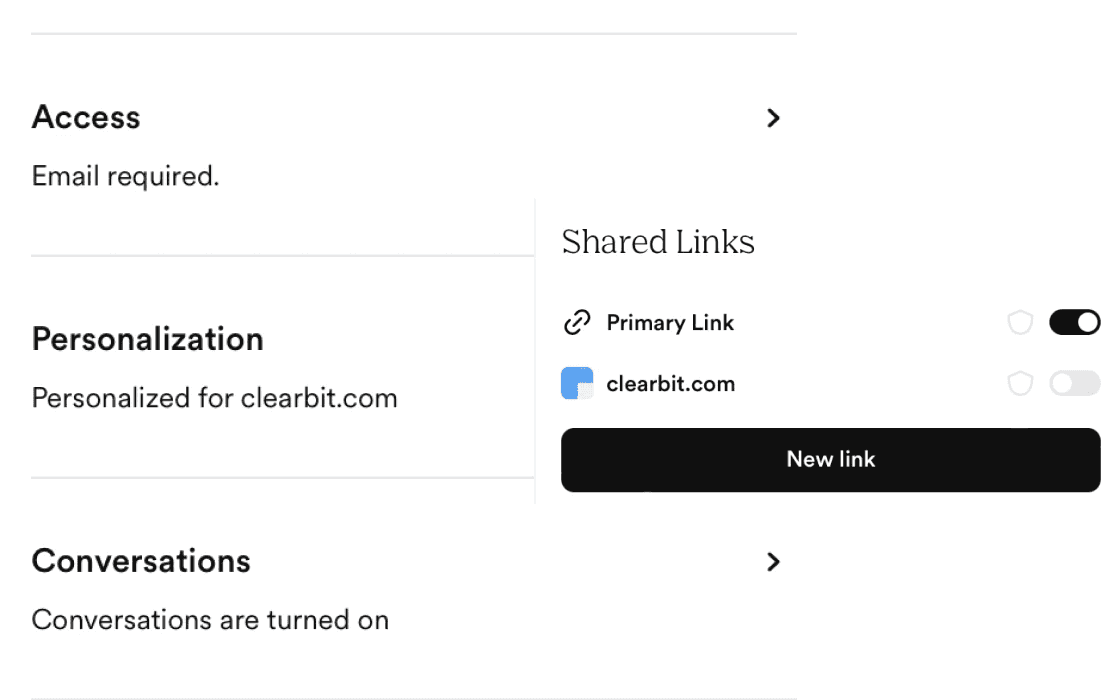
They're easily customizable. So much so that you can use intuitive pre-made templates, plus, you can choose between creating your own branded version or allowing AI to do it all for you.
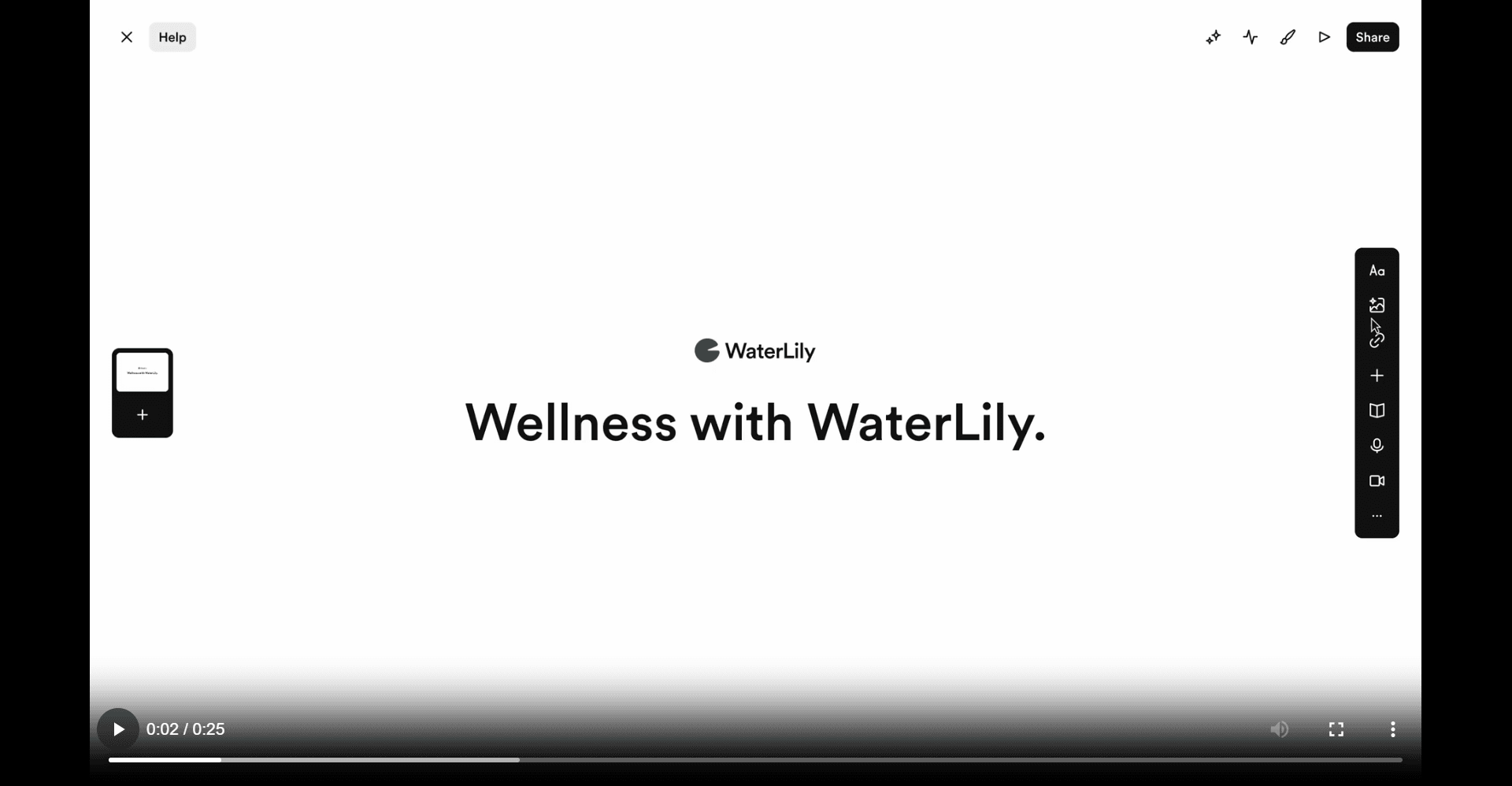
They bring everything each stakeholder needs into one place. You can embed anything from documents, videos, PDFs, attachments, GIFs, landing pages...anything. They'll look exactly as they are – not as dull blue hyperlinks.
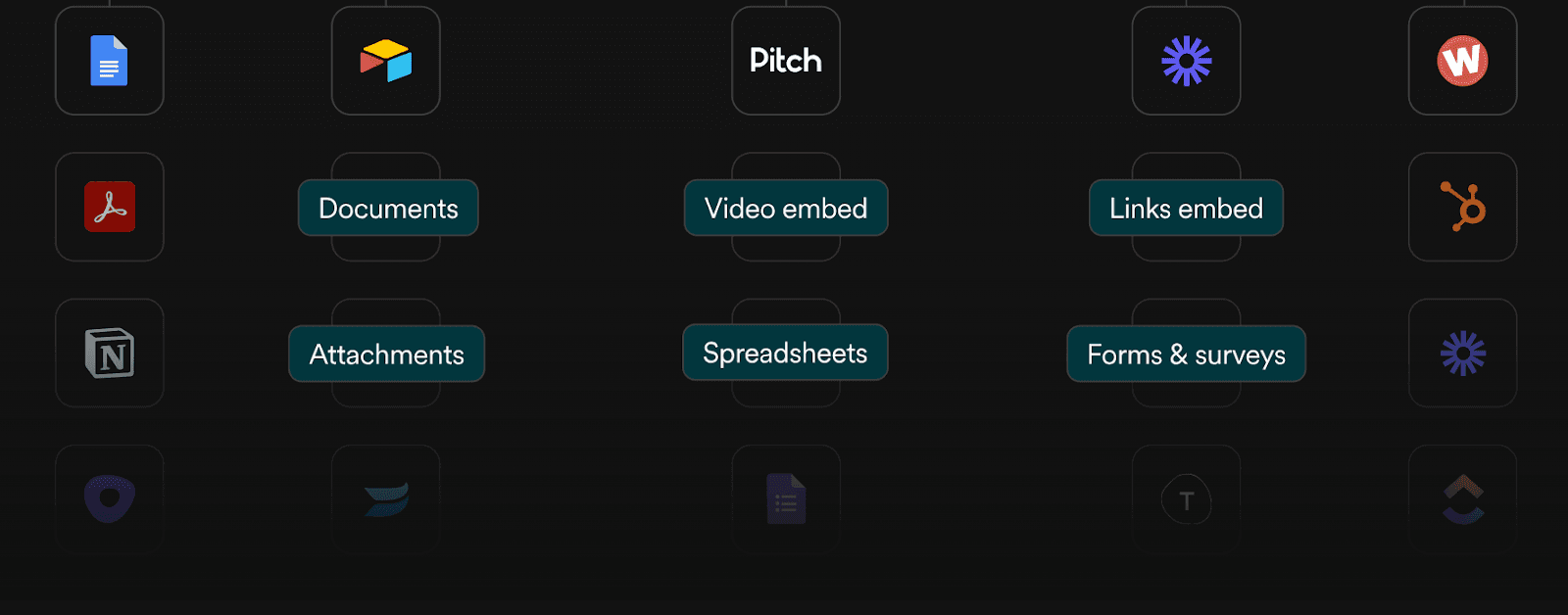
All Journeys include live commenting, so you can interact with stakeholders in real time and step in to move the deal forward. The journey also includes an AI chatbot in case stakeholders want to self-service.
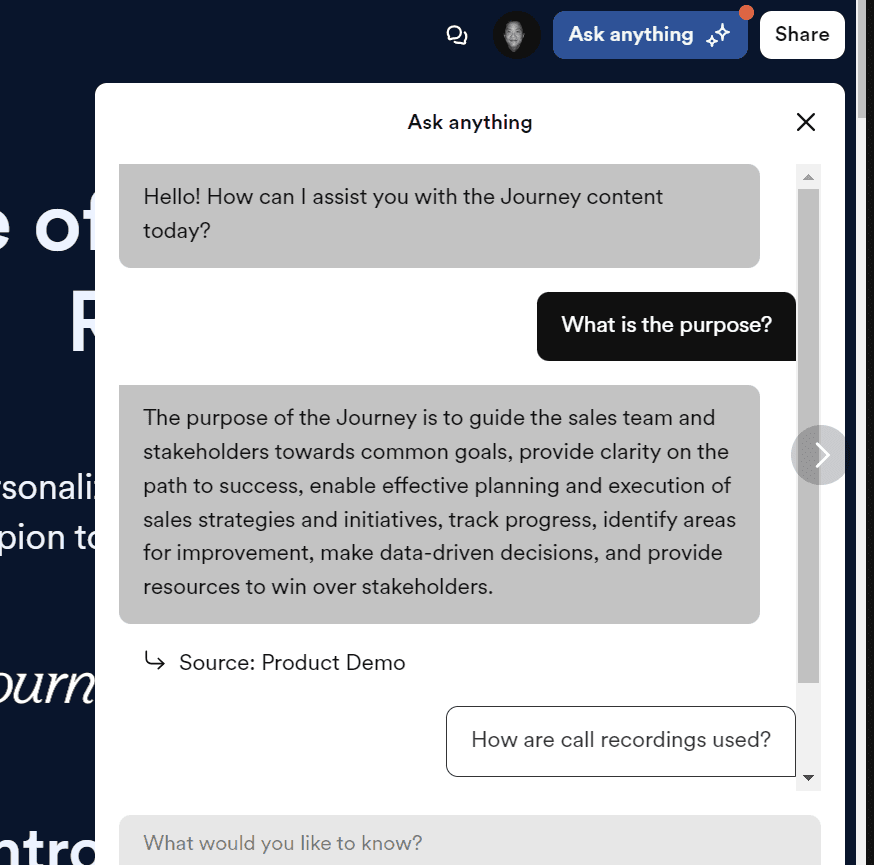
You’ll get integrations with widely used platforms such as Salesforce, Google Drive, and HubSpot, so including it in your current workflow is as easy as one click.
Get visibility into what prospects are doing, who they are, and what they’re clicking on. Offer same-time support throughout the sales journey. This feature has been recently updated in Journey, by the way! Here's what it displays:
Number of unique visitors on your journey
Total number of journey page views
Average Session Duration
Referrer source from where they clicked on Journey
Browser type of the viewer (e.g. Chrome)
Device type of the viewer (e.g., Desktop/Mobile)
You can also use filters to see the analytics on a particular month, week, or day.
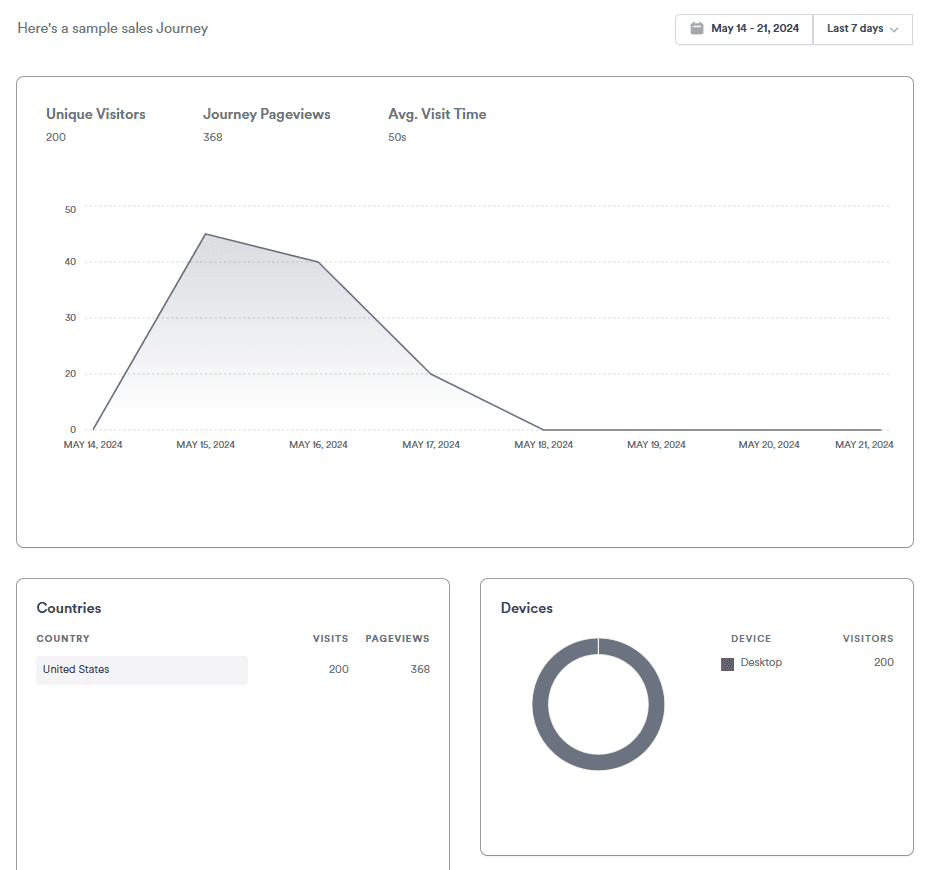
With the Right Tools, Negotiation Skills Are a Bonus
Negotiation skills are a great-to-have under your belt. It's what will give you an edge over most salespeople in the industry. You need the skills.
But you need a great first impression to make the best use of those skills. And nothing says “wow” like a smooth, and great-looking process from the get-go. Smooth things out, dress your DSRs to impress and close more deals with Journey.

Not sure about you, but I'm eagerly waiting for Season 2 of Severance.
In watching the first episode of the first season, one particular scene depicted exactly what sales negotiations can feel like – especially if you're unprepared.
The lead character, Mark Scout, has just been promoted to Department Head at his job in Lumon Industries' Macrodata Refinement (MDR) division. His first task as DH is to orient and train Helly, his coworker, on her new "reality" at the job. (It's a sci-fi psychological thriller, so the word "reality" doesn't exactly live up to its meaning.)
During the orientation, Scout finds himself feverishly shuffling through pages and pages of "talking points," including icebreakers, common questions, objections, and counter-objections, so he can know exactly what to say, regardless of the situation.
And even with all of those resources at hand, he still finds a way to mix things up and get ahead of himself. And even if he could somehow manage to memorize the whole thing, he could still mess things up.
That's because, while a sales negotiation is absolutely about the context surrounding it, the person (or people) you're selling to can shift that context in a snap.
This is the exact frame of mind I want you to have when thinking about situational sales negotiations.
What Are Situational Sales and Why Are They Different?
Every sales experience will be different regardless of how experienced you are. Sometimes, selling will feel relatively easy. Other times, it'll feel like a million punches are being thrown at you, and, just like John Wick, you need to swerve each of them masterfully.
Either way, you need to be ready for the latter option – because situational sales can be a "different species."
So, what are situational sales negotiations?
Simply put, it's the ability to adjust your approach based on many situations during the sales process, such as a customer raising unexpected objections, changes in budget or priorities, new stakeholders entering the decision-making process, or shifts in market conditions.
"So, is every B2B sales negotiation situational?"
Yes. Yes, indeed. But for some, the context won't shift as much (especially for high-intent and motivated buyers), and you won't need to maneuver so many "punches." That said, some negotiations will feel like your skills are being tested because they are.
The team at Profiliant Development Resources said it brilliantly:
"Sales Negotiations are different from all other types of negotiations because while they almost always revolve around price and discounting, each negotiation encounter can be daunting. The situation changes frequently, and the salesperson is almost always on the receiving end of demands for concessions."
In other words…taking punches. According to the team, salespeople feel pressured to give discounts, struggle past price committees and procurement officers, and make concessions to barely close the sale.
The key to mastering any situation, no matter how unexpected, isn't to become skilled in the "best sales tips and tricks." Instead, it's to...
Knowing Your Customer
Your target persona. Your ICP. Or any variation thereof.
The other B2B salespeople and I sound like a broken record at this point. But I don't mind.
According to Karan Sood, Director of Sales, B2B Sales Expert, and publisher of the MonetizeThis newsletter:
"Your total addressable market of millions of businesses is not your ideal customer profile. That's a distraction from the exercise of finding the ideal customer. This means rather than casting your customer net wide, you need to narrow it down. Far too often, customers devalue products because you are not selling to your ideal customer."
Not to mention, narrowing down your ICP makes it far easier to research and understand these customers so you can address all of their pain points and motivations during the toughest negotiations.
While on this topic, let's discuss what "knowing your customer" means and how to gather information about them.
Granted, you'll get to know your customers better as you talk face-to-face with them. And that includes nuggets of wisdom during calls. However, you'll still need to gather and analyze as much information as you can get before a meeting, such as:
Identifying key competitors and understanding how the customer differentiates itself in the market.
Reviewing the company's website to understand products or services, mission, values, and any recent news or updates.
Analyzing the company's financial health, growth trajectory, and strategic priorities.
Looking for recent announcements, partnerships, or events that might provide insights into the company's current challenges or initiatives.
Looking at the company's social media profiles to gauge its online presence, engagement with customers, and industry trends.
Bonus points: if you ask open-ended questions, listen actively, probe for pain points, and use empathy during meetings. Those are non-negotiables.
Identifying Key Stakeholders
Today, according to Gartner, "an average of 11 individual stakeholders are involved in a B2B purchase; that number can occasionally flex up to nearly 20.”
That "20" figure might make your skin crawl. Imagine catering to each stakeholder with their own agenda, authority, and influence.
Of course, not all will be key decision-makers. However informed stakeholders can still sway a major decision. You need to engage with initial contacts within the organization to identify who will be involved in the discussions.
This will help you prepare accordingly by addressing the criteria they used to evaluate products or services. Knowing their criteria is essential for aligning your strategy with their decision-making process.
Their criteria can include:
Budget constraints
Required features and integrations
Implementation timelines
Long-term strategic goals
And more.
For example, a CFO might be concerned with cost savings and ROI, while a CTO might prioritize integration capabilities and technical specifications. All of those need to be present during the sales meeting.
What Would a Good Situational Sales Negotiation Look Like In a Real Life Scenario?
Let's fabricate an example with fictional stakeholders and our superstar sales rep, Alex. He's trying to sell project management software for a fictional mid-sized technology company called TechSolutions.
The key stakeholders involved in the call are:
Sarah (CTO) is concerned with technical specifications, integration capabilities, and long-term technology strategy.
John (Project Manager), who’s focused on the software's usability, features, and reliability to streamline project management processes.
Emily (Procurement Officer), who’s responsible for negotiating terms, ensuring cost-effectiveness, and managing the financial aspects of the purchase.
Additionally, other indirect stakeholders, like the finance department, might influence the decision. Alex is well aware of that.
During the call, Alex had to manage several situations. Here are some of them, how he addressed them all, and what you could do to address them yourself.
Competitor Objections
Competition will almost always be an issue. The key is highlighting your unique value proposition and competitive advantages in the context of the call. Especially if stakeholders have been on talking terms with other companies
Here's an excerpt from our fictional call:
Alex: I get that streamlining your project management process is a key priority for TechSolutions. Our software offers advanced features like real-time collaboration, automated reporting, and integration with existing tools. How do you feel these features align with your current needs?”
Sarah (CTO): “The features sound promising, Alex. But we’ve been in talks with AgileMaster as well. They offer a similar suite of tools and have been in the market for a longer time. We’re concerned about the risk of switching to a newer provider when AgileMaster has a proven track record.”
John (Project Manager): “Yes, we’ve been using AgileMaster’s basic version for the past two years. While we’re open to exploring new options, their system’s reliability and our team’s familiarity with their interface are significant advantages for us.”
Emily (Procurement Officer): “Plus, AgileMaster has offered us a huge discount on their enterprise version because we’re an existing customer. We need to make sure that any new solution is not only superior but also cost-effective.
So, AgileMaster offers a similar suite of tools and has been in business for a longer time. You can't compete on years of experience, and in this case, you can't compete on tooling, either. What's more, the team is already familiar with their current workflow.
How can Alex get out of this bind?
By pulling the "switching" lever. This involves payment plans but doesn't involve price reductions. Emily gave him the cue, and he worked it. Here's how.
Price Resistance
Alex: "I understand the budget considerations. We’re willing to offer extended payment terms to make the transition more attractive. So, instead of the standard 30 days, we can extend the terms to 60 days for more flexibility and better cash flow management. This is an offer that AgileMaster doesn’t currently provide."
He continues, “Regarding cost-effectiveness, we offer flexible pricing plans and a dedicated support team to ensure a smooth transition with minimal disruption. We can also give you a detailed ROI analysis to compare our software's long-term benefits and savings versus AgileMaster’s current offering.”
As it turns out, Alex is a Journey user. He did his research and knew this could be a potential objection. As a result, he’s added a dedicated “ROI analysis” section to the Digital Sales Room.
Here's Why That Was a Smart Move
"(It's) fair to say discounting in B2B is the norm and not the anomaly. That goes for all B2B SAAS, non-SAAS, services, etc.," says Sood.
But should it be?
The answer is no. In fact, only three things beat pricing: budget, intent, and value perception.
Having to pull the discount lever constantly could mean that your pricing is hefty or cashflow-unfriendly. However, it's more likely that 1) Potential customers don't have the budget, 2) Their intent isn't as high as expected, or 3) The perceived value of your product doesn't seem to justify its pricing.
Trying to convince them to stretch it won't always be a good idea if they don't have the budget. That's why many salespeople use discounts.
If their intent is lower, they'll need a bit more guidance. That's where value propositions, KPIs, case studies, and video testimonials (collected using testimonial tools) can do a lot of the heavy lifting.
If your product's perceived value is low, you need to quantify and communicate the buying criteria you've identified in your research—such as ROI, total cost of ownership, and the opportunity cost of not taking action.
The pickle is...
You will have to talk about pricing eventually, and I hope it's earlier on. Here's why.
According to research from Gong Labs, close rates are highest when pricing and budgets are discussed in the first 1-2 calls. This technique is also ideal for filtering out prospects whose budgets are too low.
All that said, price and competition aren't the only stones in your shoe.
Other Roadblocks or Impasses
Sometimes, things seem to go smoothly when one unexpected objection sets you back.
A lot of these can commonly be reduced by knowing your product.
To break through this scenario, you need to identify the impasse's root causes and address them immediately. Here's how Alex did it when Sarah threw another punch his way:
Sarah (CTO): "Alex, I have another concern. Given the sensitive nature of our projects, data security and compliance with industry regulations are essential. How does your software ensure data protection, and can it comply with our industry standards?"
Alex: "Could you share more about your concerns and the regulations you must comply with? This will help me better address your questions."
Sarah: "We need to ensure that any software we use complies with GDPR and industry-specific standards like ISO 27001. Our clients entrust us with sensitive information, and any data breach could severely impact our reputation."
Alex: "Thank you. Our software is designed with robust security measures, including end-to-end encryption, regular security audits, and compliance with GDPR and ISO 27001 standards. Our dedicated security team continuously monitors and updates our systems to protect against potential threats. Would arranging a call with our Chief Security Officer to discuss our security protocols in more depth would be helpful?"
Sarah: "Yep, that would be helpful."
Next, he sets up that call and sends over the detailed documentation she requested. He also includes that documentation in the Digital Sales Room so he can be ready for this objection the next time around.
When All Is Said and Done...
You may still face objections and resistance from your customers. Expect that to happen! But don't get worked up over it because you don't need to do it all yourself. Here's what I mean by that.
Like Alex, You Can Offload the Negotiation Burden to Digital Sales Rooms (DSRs)
How, exactly, can DSRs "offload" this burden?
DSRs, especially Journey, are built (and meant!) to impress. They're also meant to simplify the lives of everyone involved – stakeholders AND sales teams. Here’s how:
DSRs are in direct competition with endless email threads and impersonal experiences. Who do you think is gonna win in B2B sales?
One secure link is all you need. If stakeholders need to share it, they'll share it easily, even with those who weren't on the call. That makes it much easier for the champion to sell your solution internally. You can control distribution with email verification, password protection, whitelists, blacklists, and expiration dates.

They're easily customizable. So much so that you can use intuitive pre-made templates, plus, you can choose between creating your own branded version or allowing AI to do it all for you.

They bring everything each stakeholder needs into one place. You can embed anything from documents, videos, PDFs, attachments, GIFs, landing pages...anything. They'll look exactly as they are – not as dull blue hyperlinks.

All Journeys include live commenting, so you can interact with stakeholders in real time and step in to move the deal forward. The journey also includes an AI chatbot in case stakeholders want to self-service.

You’ll get integrations with widely used platforms such as Salesforce, Google Drive, and HubSpot, so including it in your current workflow is as easy as one click.
Get visibility into what prospects are doing, who they are, and what they’re clicking on. Offer same-time support throughout the sales journey. This feature has been recently updated in Journey, by the way! Here's what it displays:
Number of unique visitors on your journey
Total number of journey page views
Average Session Duration
Referrer source from where they clicked on Journey
Browser type of the viewer (e.g. Chrome)
Device type of the viewer (e.g., Desktop/Mobile)
You can also use filters to see the analytics on a particular month, week, or day.

With the Right Tools, Negotiation Skills Are a Bonus
Negotiation skills are a great-to-have under your belt. It's what will give you an edge over most salespeople in the industry. You need the skills.
But you need a great first impression to make the best use of those skills. And nothing says “wow” like a smooth, and great-looking process from the get-go. Smooth things out, dress your DSRs to impress and close more deals with Journey.

Not sure about you, but I'm eagerly waiting for Season 2 of Severance.
In watching the first episode of the first season, one particular scene depicted exactly what sales negotiations can feel like – especially if you're unprepared.
The lead character, Mark Scout, has just been promoted to Department Head at his job in Lumon Industries' Macrodata Refinement (MDR) division. His first task as DH is to orient and train Helly, his coworker, on her new "reality" at the job. (It's a sci-fi psychological thriller, so the word "reality" doesn't exactly live up to its meaning.)
During the orientation, Scout finds himself feverishly shuffling through pages and pages of "talking points," including icebreakers, common questions, objections, and counter-objections, so he can know exactly what to say, regardless of the situation.
And even with all of those resources at hand, he still finds a way to mix things up and get ahead of himself. And even if he could somehow manage to memorize the whole thing, he could still mess things up.
That's because, while a sales negotiation is absolutely about the context surrounding it, the person (or people) you're selling to can shift that context in a snap.
This is the exact frame of mind I want you to have when thinking about situational sales negotiations.
What Are Situational Sales and Why Are They Different?
Every sales experience will be different regardless of how experienced you are. Sometimes, selling will feel relatively easy. Other times, it'll feel like a million punches are being thrown at you, and, just like John Wick, you need to swerve each of them masterfully.
Either way, you need to be ready for the latter option – because situational sales can be a "different species."
So, what are situational sales negotiations?
Simply put, it's the ability to adjust your approach based on many situations during the sales process, such as a customer raising unexpected objections, changes in budget or priorities, new stakeholders entering the decision-making process, or shifts in market conditions.
"So, is every B2B sales negotiation situational?"
Yes. Yes, indeed. But for some, the context won't shift as much (especially for high-intent and motivated buyers), and you won't need to maneuver so many "punches." That said, some negotiations will feel like your skills are being tested because they are.
The team at Profiliant Development Resources said it brilliantly:
"Sales Negotiations are different from all other types of negotiations because while they almost always revolve around price and discounting, each negotiation encounter can be daunting. The situation changes frequently, and the salesperson is almost always on the receiving end of demands for concessions."
In other words…taking punches. According to the team, salespeople feel pressured to give discounts, struggle past price committees and procurement officers, and make concessions to barely close the sale.
The key to mastering any situation, no matter how unexpected, isn't to become skilled in the "best sales tips and tricks." Instead, it's to...
Knowing Your Customer
Your target persona. Your ICP. Or any variation thereof.
The other B2B salespeople and I sound like a broken record at this point. But I don't mind.
According to Karan Sood, Director of Sales, B2B Sales Expert, and publisher of the MonetizeThis newsletter:
"Your total addressable market of millions of businesses is not your ideal customer profile. That's a distraction from the exercise of finding the ideal customer. This means rather than casting your customer net wide, you need to narrow it down. Far too often, customers devalue products because you are not selling to your ideal customer."
Not to mention, narrowing down your ICP makes it far easier to research and understand these customers so you can address all of their pain points and motivations during the toughest negotiations.
While on this topic, let's discuss what "knowing your customer" means and how to gather information about them.
Granted, you'll get to know your customers better as you talk face-to-face with them. And that includes nuggets of wisdom during calls. However, you'll still need to gather and analyze as much information as you can get before a meeting, such as:
Identifying key competitors and understanding how the customer differentiates itself in the market.
Reviewing the company's website to understand products or services, mission, values, and any recent news or updates.
Analyzing the company's financial health, growth trajectory, and strategic priorities.
Looking for recent announcements, partnerships, or events that might provide insights into the company's current challenges or initiatives.
Looking at the company's social media profiles to gauge its online presence, engagement with customers, and industry trends.
Bonus points: if you ask open-ended questions, listen actively, probe for pain points, and use empathy during meetings. Those are non-negotiables.
Identifying Key Stakeholders
Today, according to Gartner, "an average of 11 individual stakeholders are involved in a B2B purchase; that number can occasionally flex up to nearly 20.”
That "20" figure might make your skin crawl. Imagine catering to each stakeholder with their own agenda, authority, and influence.
Of course, not all will be key decision-makers. However informed stakeholders can still sway a major decision. You need to engage with initial contacts within the organization to identify who will be involved in the discussions.
This will help you prepare accordingly by addressing the criteria they used to evaluate products or services. Knowing their criteria is essential for aligning your strategy with their decision-making process.
Their criteria can include:
Budget constraints
Required features and integrations
Implementation timelines
Long-term strategic goals
And more.
For example, a CFO might be concerned with cost savings and ROI, while a CTO might prioritize integration capabilities and technical specifications. All of those need to be present during the sales meeting.
What Would a Good Situational Sales Negotiation Look Like In a Real Life Scenario?
Let's fabricate an example with fictional stakeholders and our superstar sales rep, Alex. He's trying to sell project management software for a fictional mid-sized technology company called TechSolutions.
The key stakeholders involved in the call are:
Sarah (CTO) is concerned with technical specifications, integration capabilities, and long-term technology strategy.
John (Project Manager), who’s focused on the software's usability, features, and reliability to streamline project management processes.
Emily (Procurement Officer), who’s responsible for negotiating terms, ensuring cost-effectiveness, and managing the financial aspects of the purchase.
Additionally, other indirect stakeholders, like the finance department, might influence the decision. Alex is well aware of that.
During the call, Alex had to manage several situations. Here are some of them, how he addressed them all, and what you could do to address them yourself.
Competitor Objections
Competition will almost always be an issue. The key is highlighting your unique value proposition and competitive advantages in the context of the call. Especially if stakeholders have been on talking terms with other companies
Here's an excerpt from our fictional call:
Alex: I get that streamlining your project management process is a key priority for TechSolutions. Our software offers advanced features like real-time collaboration, automated reporting, and integration with existing tools. How do you feel these features align with your current needs?”
Sarah (CTO): “The features sound promising, Alex. But we’ve been in talks with AgileMaster as well. They offer a similar suite of tools and have been in the market for a longer time. We’re concerned about the risk of switching to a newer provider when AgileMaster has a proven track record.”
John (Project Manager): “Yes, we’ve been using AgileMaster’s basic version for the past two years. While we’re open to exploring new options, their system’s reliability and our team’s familiarity with their interface are significant advantages for us.”
Emily (Procurement Officer): “Plus, AgileMaster has offered us a huge discount on their enterprise version because we’re an existing customer. We need to make sure that any new solution is not only superior but also cost-effective.
So, AgileMaster offers a similar suite of tools and has been in business for a longer time. You can't compete on years of experience, and in this case, you can't compete on tooling, either. What's more, the team is already familiar with their current workflow.
How can Alex get out of this bind?
By pulling the "switching" lever. This involves payment plans but doesn't involve price reductions. Emily gave him the cue, and he worked it. Here's how.
Price Resistance
Alex: "I understand the budget considerations. We’re willing to offer extended payment terms to make the transition more attractive. So, instead of the standard 30 days, we can extend the terms to 60 days for more flexibility and better cash flow management. This is an offer that AgileMaster doesn’t currently provide."
He continues, “Regarding cost-effectiveness, we offer flexible pricing plans and a dedicated support team to ensure a smooth transition with minimal disruption. We can also give you a detailed ROI analysis to compare our software's long-term benefits and savings versus AgileMaster’s current offering.”
As it turns out, Alex is a Journey user. He did his research and knew this could be a potential objection. As a result, he’s added a dedicated “ROI analysis” section to the Digital Sales Room.
Here's Why That Was a Smart Move
"(It's) fair to say discounting in B2B is the norm and not the anomaly. That goes for all B2B SAAS, non-SAAS, services, etc.," says Sood.
But should it be?
The answer is no. In fact, only three things beat pricing: budget, intent, and value perception.
Having to pull the discount lever constantly could mean that your pricing is hefty or cashflow-unfriendly. However, it's more likely that 1) Potential customers don't have the budget, 2) Their intent isn't as high as expected, or 3) The perceived value of your product doesn't seem to justify its pricing.
Trying to convince them to stretch it won't always be a good idea if they don't have the budget. That's why many salespeople use discounts.
If their intent is lower, they'll need a bit more guidance. That's where value propositions, KPIs, case studies, and video testimonials (collected using testimonial tools) can do a lot of the heavy lifting.
If your product's perceived value is low, you need to quantify and communicate the buying criteria you've identified in your research—such as ROI, total cost of ownership, and the opportunity cost of not taking action.
The pickle is...
You will have to talk about pricing eventually, and I hope it's earlier on. Here's why.
According to research from Gong Labs, close rates are highest when pricing and budgets are discussed in the first 1-2 calls. This technique is also ideal for filtering out prospects whose budgets are too low.
All that said, price and competition aren't the only stones in your shoe.
Other Roadblocks or Impasses
Sometimes, things seem to go smoothly when one unexpected objection sets you back.
A lot of these can commonly be reduced by knowing your product.
To break through this scenario, you need to identify the impasse's root causes and address them immediately. Here's how Alex did it when Sarah threw another punch his way:
Sarah (CTO): "Alex, I have another concern. Given the sensitive nature of our projects, data security and compliance with industry regulations are essential. How does your software ensure data protection, and can it comply with our industry standards?"
Alex: "Could you share more about your concerns and the regulations you must comply with? This will help me better address your questions."
Sarah: "We need to ensure that any software we use complies with GDPR and industry-specific standards like ISO 27001. Our clients entrust us with sensitive information, and any data breach could severely impact our reputation."
Alex: "Thank you. Our software is designed with robust security measures, including end-to-end encryption, regular security audits, and compliance with GDPR and ISO 27001 standards. Our dedicated security team continuously monitors and updates our systems to protect against potential threats. Would arranging a call with our Chief Security Officer to discuss our security protocols in more depth would be helpful?"
Sarah: "Yep, that would be helpful."
Next, he sets up that call and sends over the detailed documentation she requested. He also includes that documentation in the Digital Sales Room so he can be ready for this objection the next time around.
When All Is Said and Done...
You may still face objections and resistance from your customers. Expect that to happen! But don't get worked up over it because you don't need to do it all yourself. Here's what I mean by that.
Like Alex, You Can Offload the Negotiation Burden to Digital Sales Rooms (DSRs)
How, exactly, can DSRs "offload" this burden?
DSRs, especially Journey, are built (and meant!) to impress. They're also meant to simplify the lives of everyone involved – stakeholders AND sales teams. Here’s how:
DSRs are in direct competition with endless email threads and impersonal experiences. Who do you think is gonna win in B2B sales?
One secure link is all you need. If stakeholders need to share it, they'll share it easily, even with those who weren't on the call. That makes it much easier for the champion to sell your solution internally. You can control distribution with email verification, password protection, whitelists, blacklists, and expiration dates.

They're easily customizable. So much so that you can use intuitive pre-made templates, plus, you can choose between creating your own branded version or allowing AI to do it all for you.

They bring everything each stakeholder needs into one place. You can embed anything from documents, videos, PDFs, attachments, GIFs, landing pages...anything. They'll look exactly as they are – not as dull blue hyperlinks.

All Journeys include live commenting, so you can interact with stakeholders in real time and step in to move the deal forward. The journey also includes an AI chatbot in case stakeholders want to self-service.

You’ll get integrations with widely used platforms such as Salesforce, Google Drive, and HubSpot, so including it in your current workflow is as easy as one click.
Get visibility into what prospects are doing, who they are, and what they’re clicking on. Offer same-time support throughout the sales journey. This feature has been recently updated in Journey, by the way! Here's what it displays:
Number of unique visitors on your journey
Total number of journey page views
Average Session Duration
Referrer source from where they clicked on Journey
Browser type of the viewer (e.g. Chrome)
Device type of the viewer (e.g., Desktop/Mobile)
You can also use filters to see the analytics on a particular month, week, or day.

With the Right Tools, Negotiation Skills Are a Bonus
Negotiation skills are a great-to-have under your belt. It's what will give you an edge over most salespeople in the industry. You need the skills.
But you need a great first impression to make the best use of those skills. And nothing says “wow” like a smooth, and great-looking process from the get-go. Smooth things out, dress your DSRs to impress and close more deals with Journey.
Start telling better stories
Start telling better stories
Start telling better stories
Latest posts
Discover other pieces of writing in our blog


